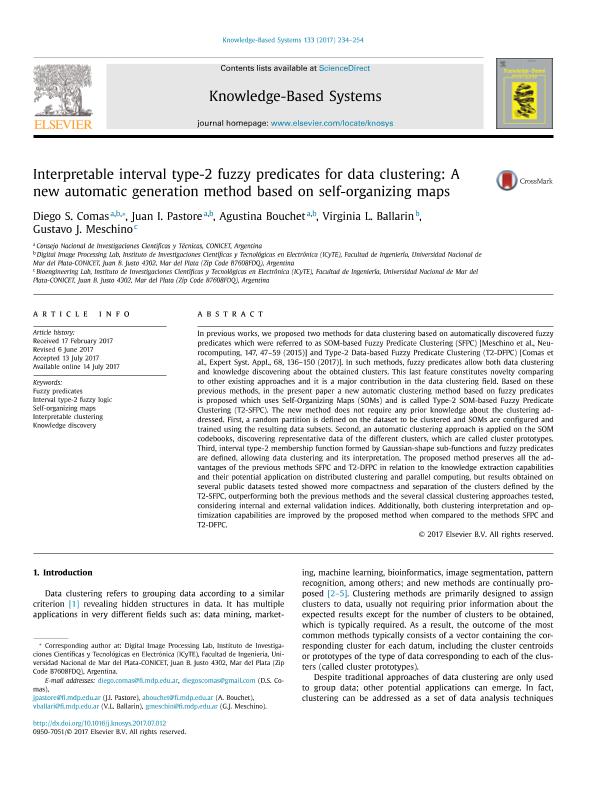Mostrar el registro sencillo del ítem
dc.contributor.author
Comas, Diego Sebastián

dc.contributor.author
Pastore, Juan Ignacio

dc.contributor.author
Bouchet, Agustina

dc.contributor.author
Ballarin, Virginia Laura

dc.contributor.author
Meschino, Gustavo Javier

dc.date.available
2018-09-05T01:29:14Z
dc.date.issued
2017-10
dc.identifier.citation
Comas, Diego Sebastián; Pastore, Juan Ignacio; Bouchet, Agustina; Ballarin, Virginia Laura; Meschino, Gustavo Javier; Interpretable interval type-2 fuzzy predicates for data clustering: A new automatic generation method based on self-organizing maps; Elsevier Science; Knowledge-Based Systems; 133; 10-2017; 234-254
dc.identifier.issn
0950-7051
dc.identifier.uri
http://hdl.handle.net/11336/58354
dc.description.abstract
In previous works, we proposed two methods for data clustering based on automatically discovered fuzzy predicates which were referred to as SOM-based Fuzzy Predicate Clustering (SFPC) [Meschino et al., Neurocomputing, 147, 47–59 (2015)] and Type-2 Data-based Fuzzy Predicate Clustering (T2-DFPC) [Comas et al., Expert Syst. Appl., 68, 136–150 (2017)]. In such methods, fuzzy predicates allow both data clustering and knowledge discovering about the obtained clusters. This last feature constitutes novelty comparing to other existing approaches and it is a major contribution in the data clustering field. Based on these previous methods, in the present paper a new automatic clustering method based on fuzzy predicates is proposed which uses Self-Organizing Maps (SOMs) and is called Type-2 SOM-based Fuzzy Predicate Clustering (T2-SFPC). The new method does not require any prior knowledge about the clustering addressed. First, a random partition is defined on the dataset to be clustered and SOMs are configured and trained using the resulting data subsets. Second, an automatic clustering approach is applied on the SOM codebooks, discovering representative data of the different clusters, which are called cluster prototypes. Third, interval type-2 membership function formed by Gaussian-shape sub-functions and fuzzy predicates are defined, allowing data clustering and its interpretation. The proposed method preserves all the advantages of the previous methods SFPC and T2-DFPC in relation to the knowledge extraction capabilities and their potential application on distributed clustering and parallel computing, but results obtained on several public datasets tested showed more compactness and separation of the clusters defined by the T2-SFPC, outperforming both the previous methods and the several classical clustering approaches tested, considering internal and external validation indices. Additionally, both clustering interpretation and optimization capabilities are improved by the proposed method when compared to the methods SFPC and T2-DFPC.
dc.format
application/pdf
dc.language.iso
eng
dc.publisher
Elsevier Science

dc.rights
info:eu-repo/semantics/openAccess
dc.rights.uri
https://creativecommons.org/licenses/by-nc-sa/2.5/ar/
dc.subject
Fuzzy Predicates
dc.subject
Interpretable Clustering
dc.subject
Interval Type-2 Fuzzy Logic
dc.subject
Knowledge Discovery
dc.subject
Self-Organizing Maps
dc.subject.classification
Ingeniería de Sistemas y Comunicaciones

dc.subject.classification
Ingeniería Eléctrica, Ingeniería Electrónica e Ingeniería de la Información

dc.subject.classification
INGENIERÍAS Y TECNOLOGÍAS

dc.title
Interpretable interval type-2 fuzzy predicates for data clustering: A new automatic generation method based on self-organizing maps
dc.type
info:eu-repo/semantics/article
dc.type
info:ar-repo/semantics/artículo
dc.type
info:eu-repo/semantics/publishedVersion
dc.date.updated
2018-08-13T17:24:24Z
dc.journal.volume
133
dc.journal.pagination
234-254
dc.journal.pais
Países Bajos

dc.journal.ciudad
Amsterdam
dc.description.fil
Fil: Comas, Diego Sebastián. Consejo Nacional de Investigaciones Científicas y Técnicas. Centro Científico Tecnológico Conicet - Mar del Plata. Instituto de Investigaciones Científicas y Tecnológicas en Electrónica. Universidad Nacional de Mar del Plata. Facultad de Ingeniería. Instituto de Investigaciones Científicas y Tecnológicas en Electrónica.; Argentina
dc.description.fil
Fil: Pastore, Juan Ignacio. Consejo Nacional de Investigaciones Científicas y Técnicas. Centro Científico Tecnológico Conicet - Mar del Plata. Instituto de Investigaciones Científicas y Tecnológicas en Electrónica. Universidad Nacional de Mar del Plata. Facultad de Ingeniería. Instituto de Investigaciones Científicas y Tecnológicas en Electrónica.; Argentina
dc.description.fil
Fil: Bouchet, Agustina. Consejo Nacional de Investigaciones Científicas y Técnicas. Centro Científico Tecnológico Conicet - Mar del Plata. Instituto de Investigaciones Científicas y Tecnológicas en Electrónica. Universidad Nacional de Mar del Plata. Facultad de Ingeniería. Instituto de Investigaciones Científicas y Tecnológicas en Electrónica.; Argentina
dc.description.fil
Fil: Ballarin, Virginia Laura. Consejo Nacional de Investigaciones Científicas y Técnicas. Centro Científico Tecnológico Conicet - Mar del Plata. Instituto de Investigaciones Científicas y Tecnológicas en Electrónica. Universidad Nacional de Mar del Plata. Facultad de Ingeniería. Instituto de Investigaciones Científicas y Tecnológicas en Electrónica.; Argentina
dc.description.fil
Fil: Meschino, Gustavo Javier. Consejo Nacional de Investigaciones Científicas y Técnicas. Centro Científico Tecnológico Conicet - Mar del Plata. Instituto de Investigaciones Científicas y Tecnológicas en Electrónica. Universidad Nacional de Mar del Plata. Facultad de Ingeniería. Instituto de Investigaciones Científicas y Tecnológicas en Electrónica.; Argentina. Universidad Nacional de Mar del Plata. Facultad de Ingeniería. Departamento de Ingeniería Eléctrica. Laboratorio de Bioingeniería; Argentina
dc.journal.title
Knowledge-Based Systems

dc.relation.alternativeid
info:eu-repo/semantics/altIdentifier/url/https://www.sciencedirect.com/science/article/pii/S0950705117303313
dc.relation.alternativeid
info:eu-repo/semantics/altIdentifier/doi/http://dx.doi.org/10.1016/j.knosys.2017.07.012
Archivos asociados
